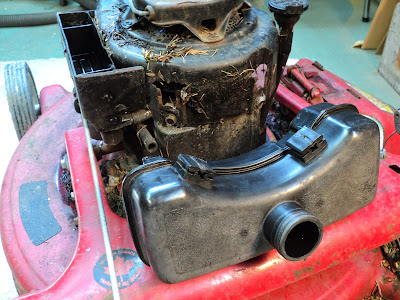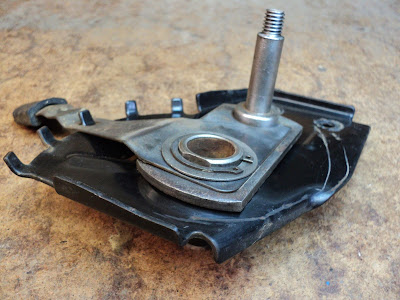The subject engine is on a base model lawnmower, so it's a fixed-speed version -- about as simple as it gets.
The engine has seen a couple of seasons of use. It still starts and runs ok, but not perfectly to my ear. I don't like what I see when I peer into the fuel tank, so I'll get it off the engine for a thorough flush. I'd like to have a trouble-free season from the mower.
- - -
Here's a view of the fuel tank/carb/air cleaner corner of the engine.
The carburetor is a departure from what I'm accustomed to seeing on Briggs & Stratton engines -- this one has a primer bulb on it like the Tecumsehs.
- - -
Air Cleaner
A single long screw holds the air cleaner in place.
There's a ring gasket under the air cleaner's body on the carburetor's air intake horn.
Governor Linkage
There's an operator's lever that's spring-linked to the governor. I can't see that the lever does much of anything, and neither the engine manual nor the mower manual explain the thing. Other than that, the governor linkage is as one would expect -- there's a rigid link between the air vane's arm and the throttle; spring tension on the air vane's arm determines governed speed.[1]
The operator's-lever/spring-linkage affair is anchored on a bracket that's attached to the engine by two of the cylinder head's bolts. That says that the bracket is not to be disturbed.
Fuel Tank And Carburetor
The fuel tank and carburetor are removed as a unit. Proceed as follows:
1) Crankcase ventilation elbow fitting slipped off of carburetor nipple.
2) At front of fuel tank, one 1/4"-20 x 9/16" hex washerhead screw, 3/8" A/F.
3) At top of fuel tank, one 5/16"-18 x 1 3/4" hex washerhead screw, 1/2" A/F.
4) Free the governor link from the carburetor's throttle plate as you take away the unfastened unit.
The above four steps get you to here.
Carburetor Removal
Five No. 2 Phillips recess screws fasten the carburetor to the fuel tank. (The screws are 10-32 x 9/16".)
Here's a view of the carburetor off the fuel tank, after a cleaning in the parts washer.
Note the following:
- The diaphragm goes directly against the fuel tank; the gasket goes directly against the carburetor.
- The carburetor's body is entirely made of plastic.
- There's no torsion spring on the throttle butterfly.
- There's a spring in the carburetor that's free to come off its post once the diaphragm is removed.
- I haven't disturbed the primer bulb. It's probably unwise to unless a new bulb and retaining clip are on hand.
- The diaphragm is the weak point in this carburetor.[2] 'Best to have a new one on hand if you're going this far.
- There's an o-ring in the carburetor's output air horn that seals around the engine's intake tube. That seal has to be flawless for the engine to run reliably at full power. Inspect and lubricate the o-ring before re-installing the carburetor.
- - -
Notes:
[1] The governor spring's tension works to open the throttle; greater governor spring tension results in a higher governed speed.
Air vane deflection works to close the throttle; increased deflection from increasing engine speed works to return engine speed to set governed speed.
When governor spring tension and air vane deflection strike a balance, governed speed results.
[2] Diaphragms are weak points in any carburetor, for that matter. The so-called 'literature' on small engine maintenance makes much of inspecting diaphragms for punctures or tears. Nothing in an engine's normal operation is ever going to puncture or tear a diaphragm. Diaphragms do stretch and stiffen somewhat with age, though. That's what renders them marginally fit or wholly unfit for service. The symptom is simply poor/erratic engine performance. Any engine that's seen two or more seasons of use is probably due for a new diaphragm. (I'm told that using ethanol-free gasoline will greatly extend the life of diaphragms.)
Here's a view of an old diaphragm alongside a new one.
The old diaphragm is at the left. Note the stretching and stiffening in the area where the spring bears down on it. That diaphragm still works, but it's subpar.
The diaphragm in this carburetor is strictly a fuel pump and valves. The metering diaphragms in two-stroke engine carburetors are much less tolerant of stiffening; a stiffened metering diaphragm will likely render an engine inoperative with the choke off.
# # #
# # #
































































